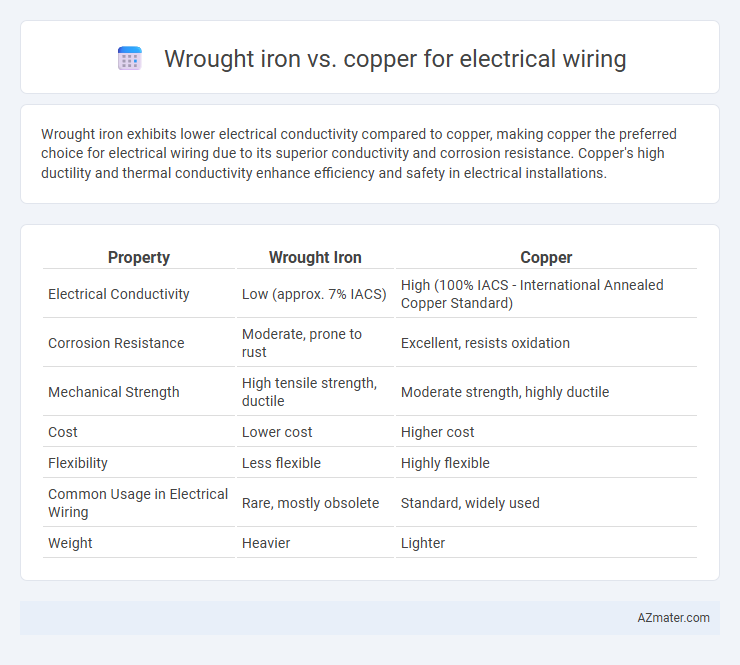Wrought iron exhibits lower electrical conductivity compared to copper, making copper the preferred choice for electrical wiring due to its superior conductivity and corrosion resistance. Copper's high ductility and thermal conductivity enhance efficiency and safety in electrical installations.
Table of Comparison
| Property | Wrought Iron | Copper |
|---|---|---|
| Electrical Conductivity | Low (approx. 7% IACS) | High (100% IACS - International Annealed Copper Standard) |
| Corrosion Resistance | Moderate, prone to rust | Excellent, resists oxidation |
| Mechanical Strength | High tensile strength, ductile | Moderate strength, highly ductile |
| Cost | Lower cost | Higher cost |
| Flexibility | Less flexible | Highly flexible |
| Common Usage in Electrical Wiring | Rare, mostly obsolete | Standard, widely used |
| Weight | Heavier | Lighter |
Introduction to Electrical Wiring Materials
Copper is the preferred material for electrical wiring due to its exceptional electrical conductivity, corrosion resistance, and ductility, making it efficient for transmitting electrical current. Wrought iron, though historically used, has poor conductivity and is prone to rust, which reduces its effectiveness and safety in modern electrical installations. The superior properties of copper, including its tensile strength and reliability in various environmental conditions, make it the standard choice in residential and commercial wiring systems.
Overview of Wrought Iron in Electrical Applications
Wrought iron is rarely used in modern electrical wiring due to its lower electrical conductivity compared to copper, which limits its efficiency in conducting electricity. Its primary advantage lies in mechanical strength and resistance to corrosion, making it suitable for protective or structural components rather than active electrical conductors. Copper remains the preferred material for electrical wiring because of its superior conductivity, flexibility, and durability.
Copper: Properties and Uses in Wiring
Copper exhibits excellent electrical conductivity, corrosion resistance, and malleability, making it the preferred material for electrical wiring over wrought iron. Its high conductivity minimizes energy loss, ensuring efficient power transmission in residential, commercial, and industrial applications. Copper's durability and resistance to oxidation contribute to long-lasting wiring systems with reduced maintenance requirements.
Conductivity Comparison: Wrought Iron vs Copper
Copper exhibits significantly higher electrical conductivity than wrought iron, measuring about 5.96 x 10^7 S/m compared to wrought iron's approximately 1.0 x 10^7 S/m. This superior conductivity allows copper wiring to transmit electrical currents more efficiently with less energy loss and reduced heat generation. Consequently, copper is the preferred material in electrical wiring for minimizing resistance and improving overall circuit performance.
Mechanical Strength and Durability
Wrought iron exhibits superior mechanical strength compared to copper, making it more resistant to physical damage and deformation in electrical wiring applications. Despite this, copper offers better durability in terms of corrosion resistance and longevity, ensuring consistent electrical conductivity over time. The choice between wrought iron and copper depends on prioritizing mechanical robustness or long-term reliability in wiring installations.
Corrosion Resistance Differences
Copper exhibits excellent corrosion resistance in electrical wiring due to its ability to form a stable oxide layer that prevents further degradation, ensuring long-term conductivity and reliability. In contrast, wrought iron is more susceptible to oxidation and rust, leading to potential deterioration of electrical connections and compromised performance over time. This difference makes copper the preferred choice for wiring in environments prone to moisture and corrosive elements.
Safety Considerations in Electrical Installations
Copper offers superior conductivity and corrosion resistance, significantly reducing the risk of overheating and electrical fires in wiring installations. Wrought iron, while sturdy, has higher resistance and poor corrosion resistance, which can cause increased heat generation and potential safety hazards. For electrical safety, copper is the preferred material due to its ability to maintain stable electrical performance and lower fire risk in residential and commercial wiring systems.
Cost Analysis: Wrought Iron vs Copper Wiring
Wrought iron wiring tends to have a lower upfront cost compared to copper but often incurs higher maintenance expenses due to its susceptibility to corrosion and lower conductivity. Copper wiring shows higher initial material costs but provides better long-term value through enhanced durability, superior electrical conductivity, and reduced energy losses. Cost analysis must weigh immediate budget constraints against operational efficiency and lifespan, favoring copper for most modern electrical applications.
Environmental Impact and Sustainability
Wrought iron, although durable, is less commonly used in electrical wiring due to its higher carbon footprint and energy-intensive production process compared to copper. Copper offers superior recyclability and conductivity, making it a more sustainable choice with lower environmental impact over its lifecycle. Its widespread recycling infrastructure reduces demand for virgin mining, significantly minimizing resource depletion and pollution.
Choosing the Right Material for Electrical Projects
Wrought iron is rarely used for electrical wiring due to its high resistance and poor conductivity compared to copper, which remains the preferred choice for electrical projects because of its excellent conductivity, durability, and corrosion resistance. Copper's low resistivity (approximately 1.68 x 10^-8 ohm-meters) ensures efficient current flow, reducing energy loss and heat generation in wiring systems, while wrought iron's higher resistivity and susceptibility to corrosion limit its practicality and lifespan in electrical applications. When selecting wiring materials, prioritizing copper ensures safer, more efficient, and long-lasting electrical installations suitable for residential, commercial, and industrial projects.

Infographic: Wrought iron vs Copper for Electrical wiring
 azmater.com
azmater.com